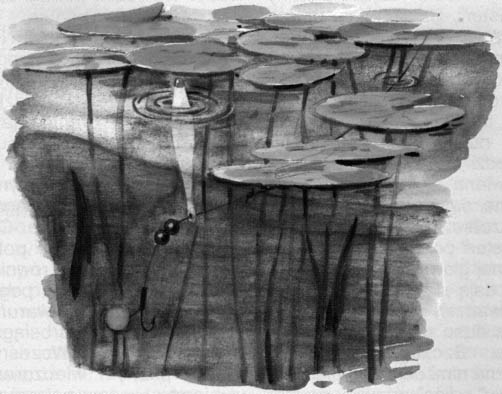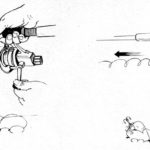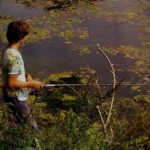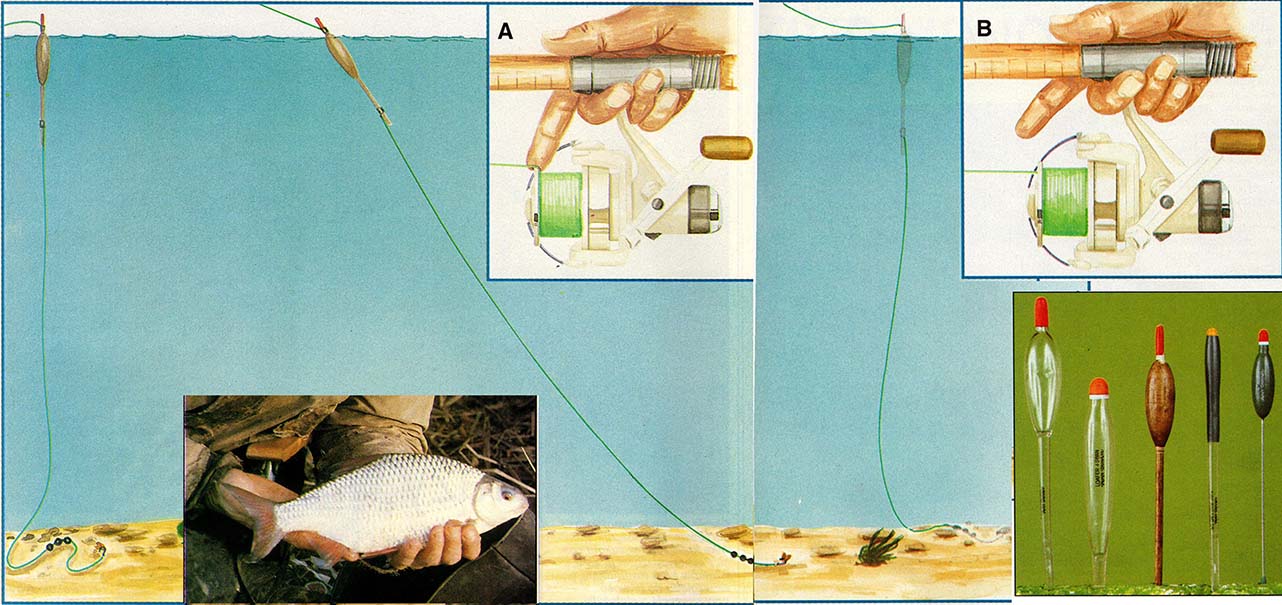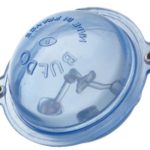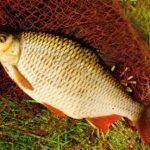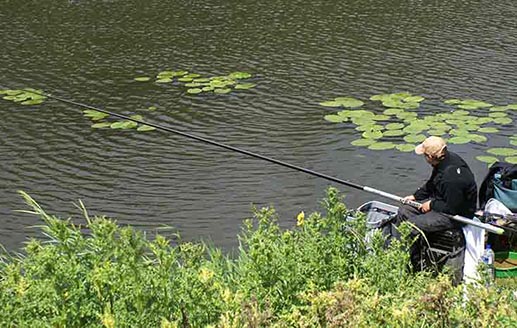 Wędkowanie wśród roślinności wodnej jest zawsze bardzo efektywne – w rzekach pod pływającymi dywanami zielska stoją nie tylko klenie i brzany.
Wędkowanie wśród roślinności wodnej jest zawsze bardzo efektywne – w rzekach pod pływającymi dywanami zielska stoją nie tylko klenie i brzany.
Wędkarze rzeczni z pewnością się pod tym podpiszą – tam, gdzie na powierzchni widać liście roślinności wodnej, tam także gromadzą się ryby.
W cieniu zielonych pływających dywanów szukają pożywienia przecie wszystkim klenie, brzany, płocie i jelce. Prawie we wszystkich dywanach znajdują się dziury i tunele z wolną wodą. Miejsca te są bardzo łatwe do obłowienia. W tunelach wśród roślinności wodnej regularnie odnoszę sukcesy zarówno na spławik, jak i na grunt. Spławikowi pozwalam dryfować wzdłuż pasa roślinności. Decydując się na łowienie z gruntu zwracam uwagę na to, aby moją przynętę wniosło pod dywan, a tam już same rośliny przytrzymają ją w miejscu. Znacznie trudniej jest. gdy gęsta roślinność wodna porasta całe łowisko. Na pierwszy rzut oka odnosi się wrażenie, że nie ma nawet jak wrzucić do wody przynęty. Większość kolegów, kierujących się w życiu zasadą wykonywania wszystkiego po jak najmniejszej linii oporu, od razu omija takie miejsca i próbuje szczęścia na innych odcinkach rzeki z niewielką ilością roślinności wodnej.
Pod dywanem
Mamy tu do czynienia z dosyć dziwną sytuacją polegającą na tym, że latem prawie nikt nie łowi w miejscach, w których koncentruje się większość ryb z rzeki. Dlatego też pragnę zdradzić Wam kilka sposobów, jak można skutecznie obłowić nawet najbardziej zarośnięte odcinki rzeki. Najpierw musimy sobie jedno wyjaśnić – przyglądając się łowisku widzimy tylko górną powierzchnię zielonego dywanu roślinności, natomiast zupełnie nie jesteśmy w stanie zobaczyć tego, co najistotniejsze – ukształtowania dna. Czasami wśród roślinności wodnej ukryte są leżące na dnie zawady, dołki łub małe podwodne górki. Te charakterystyczne miejsca przyciągają ryby z magiczną siłą. Czasami wystarczy tylko zwykły baldachim z roślinności – ryby znajdują pod nim schronienie przed promieniami słońca, ciągle też spadają im na głowy larwy owadów stanowiące ich główny pokarm.
Sondowanie z wyczuciem
Oczywiście nie dotyczy to zimy, gdy roślinność wodna opada na dno i obumiera. W chłodnych miesiącach roku woda płynie w korycie rzeki znacznie szybciej. Ryby starają się wtedy nie tracić niepotrzebnie energii na ciągłe utrzymywanie się w prądzie i stoją w zagłębieniach m dnie rzeki. Wędkarz pragnący odnosić sukcesy musi po prostu wiedzieć, gdzie znajdują się takie dołki. Jak je znaleźć? Najprostsza metoda polega na dokładnym wysondowaniu całego pasa roślinności. Musimy przy tym używać dość dużego ciężarka, gdyż tylko wtedy nasze pomiary będą naprawdę dokładne. Lekki ciężarek sondujący nie zawsze dochodzi do dna, gdyż czasami zatrzymuje się na gęstej roślinności wodnej. Czasami też jest unoszony trochę z prądem rzeki – spławik zestawu sondującego idzie wtedy pod wodę. a nam się wydaje, że łowisko jest głębsze, niż w rzeczywistości. Radzę dokładnie wysondować możliwie jak najwięcej miejsc, gdyż tylko w ten sposób będziemy mieli w miarę dokładny obraz ukształtowania dna. Na wielu odcinkach porośniętych roślinnością wodną rzeki są przeważnie płytkie. W tym przypadku dokładne sondowanie, centymetr po centymetrze jest tylko niepotrzebną stratą czasu. Znacznie lepszym i efektywniejszym sposobem jest brodzenie, czy to w spodniobutach, czy to w kąpielówkach. Brodzenie zaczynam zawsze od górnej granicy wytypowanego przeze mnie odcinka i bardzo powoli schodzę z prądem. Przez cały czas dokładnie sprawdzam teleskopową rączką podbieraka dno rzeki przed sobą, dzięki czemu jeszcze nigdy nie zdarzyło się mi, abym nagle zniknął pod wodą. W trakcie poszukiwań prawie zawsze natrafiam na dołki w dnie, a w wielu takich miejscach rzeka jest nawet o metr głębsza niż normalnie. Po znalezieniu atrakcyjnych dołków zadaję sobie zawsze dwa pytania -w jaki sposób przygotować to miejsce do wędkowania oraz w jaki sposób będę ryby? Jeżeli na jakimś płytkim (a więc prawie zawsze zarośniętym) odcinku rzeki uda nam się zlokalizować w dnie wyraźne zagłębienie, możemy być pewni, iż w miejscu tym gromadzi się wiele różnych ryb, przeważnie brzany i klenie, gdyż są to gatunki mających szczególne upodobanie do miejsc porośniętych roślinnością wodną.
Z zachowaniem odległości
Jeszcze kilka lat temu postępowałem mniej więcej tak – usuwałem część roślinności wodnej nad zagłębieniem (ułatwienie w zarzucaniu zestawu), nęciłem i wędkowałem bezpośrednio w dołku. Udawało mi się w ten sposób złowić wiele ryb, jednak bardzo szybko pojawił się pewien problem – ciągle niepokojone brzany z czasem na dobre opuszczały to miejsce. Dzisiaj podchodzę do sprawy zupełnie inaczej – nie łowię już w samym dołku, lecz około pięciu metrów powyżej. Ryby odnajdują moją zanętę (przynętę) kierując się węchem (zapach smugi zanętowej). Powyższy sposób wędkowania ma jedną wielką zaletę – zaniepokojone brzany (holem jednej lub kilku z nich) mogą natychmiast schronić się w „domu”, czyli w pobliskim dołku.
Łowienie bezpośrednio nad zagłębieniem w dnie ciągle płoszy brzany w ich naturalnej kryjówce i istnieje poważne niebezpieczeństwo, że z czasem ryby opuszczą to miejsce i przeniosą się na jakiś inny odcinek rzeki. Wcześniej zdarzało mi się to wielokrotnie. Wędkując kilka metrów od „domu” brzan wiem doskonale, dokąd ucieknie spłoszona ryba po zerwaniu się z haczyka. Zostawiam ją wtedy w spokoju, żeby się uspokoiła i wyzbyła podejrzliwości. Po jakimś czasie głód i tak da znać o sobie i brzana ponownie zjawi się w pobliżu mojej przynęty.
